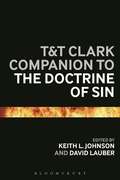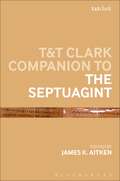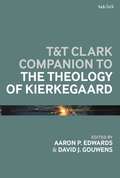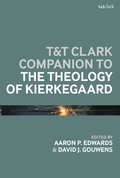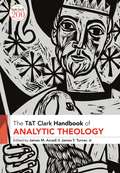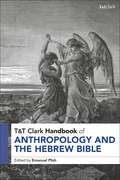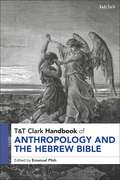- Table View
- List View
T&T Clark Companion to Reformation Theology (Bloomsbury Companions)
by David M WhitfordThis volume introduces the main theological topics of Reformation theology in a language that is clear and concise. Theology in the Reformation era can be complicated and contentious. This volume aims to cut through the theological jargon and explain what people believed and why.The book begins with an essay that explains to students how one can approach the study of 16th century theology. It includes a guide to major events, persons, doctrines, and movements.
T&T Clark Companion to the Bible and Film (Bloomsbury Companions)
by Richard WalshThe first decades of the twenty-first century saw a resurgence of the biblical epic film, such as Noah and Exodus: Gods and Kings, which was in turn accompanied by a growth of biblical film criticism. This companion surveys that field of study by framing it in light of significant and recent biblical films as well as the voices of key biblical film critics. Non-Hollywood and seemingly “non-biblical” films also come under investigation.The contributors concentrate on three points: “context”, focusing on the 'Bible in' specific film genres and cultural situations; “theory”, applying theory from both religion and film studies, with an eye to their possible intersections; and “recent and significant texts”, reflecting on which texts and themes have been most important in 'biblical film' and which are currently at the fore. Exploring cinema across the globe, and accompanied by extended introductory essays for each of the three sections, this companion is an important resource for scholars in both film and biblical reception.
T&T Clark Companion to the Bible and Film (Bloomsbury Companions)
by Richard WalshThe first decades of the twenty-first century saw a resurgence of the biblical epic film, such as Noah and Exodus: Gods and Kings, which was in turn accompanied by a growth of biblical film criticism. This companion surveys that field of study by framing it in light of significant and recent biblical films as well as the voices of key biblical film critics. Non-Hollywood and seemingly "non-biblical” films also come under investigation.The contributors concentrate on three points: "context”, focusing on the 'Bible in' specific film genres and cultural situations; "theory”, applying theory from both religion and film studies, with an eye to their possible intersections; and "recent and significant texts”, reflecting on which texts and themes have been most important in 'biblical film' and which are currently at the fore. Exploring cinema across the globe, and accompanied by extended introductory essays for each of the three sections, this companion is an important resource for scholars in both film and biblical reception.
T&T Clark Companion to the Dead Sea Scrolls (Bloomsbury Companions)
by George J. Brooke Charlotte HempelThe Dead Sea Scrolls are one of the most important archaeological discoveries of the last century. They have great historical, religious, and linguistic significance, not least in relation to the transmission of many of the books which came to be included in the Hebrew Bible. This companion comprises over 70 articles, exploring the entire body of the key texts and documents labelled as Dead Sea Scrolls.Beginning with a section on the complex methods used in discovering, archiving and analysing the Scrolls, the focus moves to consideration of the Scrolls in their various contexts: political, religious, cultural, economic and historical. The genres ascribed to groups of texts within the Scrolls- including exegesis and interpretation, poetry and hymns, and liturgical texts - are then examined, with due attention given to both past and present scholarship. The main body of the Companion concludes with crucial issues and topics discussed by leading scholars. Complemented by extensive appendices and indexes, this Companion provides the ideal resource for those seriously engaging with the Dead Sea Scrolls.
T&T Clark Companion to the Dead Sea Scrolls (Bloomsbury Companions)
by George J. Brooke Charlotte HempelThe Dead Sea Scrolls are one of the most important archaeological discoveries of the last century. They have great historical, religious, and linguistic significance, not least in relation to the transmission of many of the books which came to be included in the Hebrew Bible. This companion comprises over 70 articles, exploring the entire body of the key texts and documents labelled as Dead Sea Scrolls.Beginning with a section on the complex methods used in discovering, archiving and analysing the Scrolls, the focus moves to consideration of the Scrolls in their various contexts: political, religious, cultural, economic and historical. The genres ascribed to groups of texts within the Scrolls- including exegesis and interpretation, poetry and hymns, and liturgical texts - are then examined, with due attention given to both past and present scholarship. The main body of the Companion concludes with crucial issues and topics discussed by leading scholars. Complemented by extensive appendices and indexes, this Companion provides the ideal resource for those seriously engaging with the Dead Sea Scrolls.
T&T Clark Companion to the Doctrine of Sin (Bloomsbury Companions)
by Keith L. Johnson David LauberThe T&T Clark Companion to the Doctrine of Sin provides a comprehensive treatment of the doctrine of sin. The Companion includes an examination of the biblical and rabbinic accounts of sin, and it provides accounts of sin and its effects offered by key theologians throughout Christian history. It also explores debates surrounding the implications of sin for various doctrines, including God, creation, anthropology, and salvation. The book is comprised of 30 major essays that provide an unparalleled examination of the key texts, figures, and debates relevant to the Christian tradition's discussion of the doctrine of sin. The Companion is unique in that every essay seeks to both appropriate and further stimulate the church's understanding of sin and its implications for the whole of the church's dogmatic tradition. The essays are divided into three sections: (1) Biblical Background; (2) Major Figures and Traditions; and (3) Dogmatic Concerns. The first set of essays explores the biblical and rabbinic accounts of sin to bring out the complexities of the biblical presentation and its implications. The second section discusses the role of the doctrine of sin in the theology of key theologians with a special attention to explaining how the doctrine contributes to an understanding of their overall theology. The final section explores key dogmatic questions and concerns related to the doctrine of sin (e.g. original sin, sin and the question of evil and providence, sin and the freedom of the will).
T&T Clark Companion to the Doctrine of Sin (Bloomsbury Companions)
by David Lauber Dr Keith L. JohnsonThe T&T Clark Companion to the Doctrine of Sin provides a comprehensive treatment of the doctrine of sin. The Companion includes an examination of the biblical and rabbinic accounts of sin, and it provides accounts of sin and its effects offered by key theologians throughout Christian history. It also explores debates surrounding the implications of sin for various doctrines, including God, creation, anthropology, and salvation. The book is comprised of 30 major essays that provide an unparalleled examination of the key texts, figures, and debates relevant to the Christian tradition's discussion of the doctrine of sin. The Companion is unique in that every essay seeks to both appropriate and further stimulate the church's understanding of sin and its implications for the whole of the church's dogmatic tradition. The essays are divided into three sections: (1) Biblical Background; (2) Major Figures and Traditions; and (3) Dogmatic Concerns. The first set of essays explores the biblical and rabbinic accounts of sin to bring out the complexities of the biblical presentation and its implications. The second section discusses the role of the doctrine of sin in the theology of key theologians with a special attention to explaining how the doctrine contributes to an understanding of their overall theology. The final section explores key dogmatic questions and concerns related to the doctrine of sin (e.g. original sin, sin and the question of evil and providence, sin and the freedom of the will).
T&T Clark Companion to the Septuagint (Bloomsbury Companions)
by James K AitkenThe Septuagint is the Greek translation of the Hebrew Bible and the scriptures read by early Christians. Septuagint studies have been a growth field in the past twenty years. It has become an area of interest not only for textual criticism of the Hebrew Bible but as a product of Judaism in the Graeco-Roman world. It is even being utilized occasionally by scholars of Greek religion. At the same time renewed interest in the daughter versions (Syriac, Vulgate, Ethiopic, Coptic etc.) has thrown new attention onto the Septuagint. This Companion provides a cutting-edge survey of scholarly opinion on the Septuagint text of each biblical book. It covers the characteristics of each Septuagint book, its translation features, origins, text-critical problems and history. As such it provides a comprehensive companion to the Septuagint, featuring contributions from experts in the field.
T&T Clark Companion to the Theology of Kierkegaard (T&T Clark Handbooks)
by David J. Gouwens Aaron P. EdwardsThis companion explores Søren Kierkegaard's importance as a critical and constructive theological thinker, offering a comprehensive reading of his work through a distinctly theological lens, including interpretative concerns, his approach to specific doctrines, and theological trajectories for thinking beyond his work. Beginning with essays on key interpretative factors involved in approaching Kierkegaard's complex corpus, there are also historical accounts of his theological development, followed by – for the first time in a single volume – focused expositions of Kierkegaard's approach to particular doctrinal themes, from those oft-discussed in his work (e.g. Christology) to those more understated (e.g. Pneumatology). The book concludes with theological trajectories for Kierkegaard's thought in the 21st century. This volume helps not only to situate Kierkegaard's theology more firmly on the map, but to situate Kierkegaard more firmly on the theological map, as one who has much to offer both the form and content of the theological task.
T&T Clark Companion to the Theology of Kierkegaard (T&T Clark Handbooks)
by David J. Gouwens Aaron P. EdwardsThis companion explores Søren Kierkegaard's importance as a critical and constructive theological thinker, offering a comprehensive reading of his work through a distinctly theological lens, including interpretative concerns, his approach to specific doctrines, and theological trajectories for thinking beyond his work. Beginning with essays on key interpretative factors involved in approaching Kierkegaard's complex corpus, there are also historical accounts of his theological development, followed by – for the first time in a single volume – focused expositions of Kierkegaard's approach to particular doctrinal themes, from those oft-discussed in his work (e.g. Christology) to those more understated (e.g. Pneumatology). The book concludes with theological trajectories for Kierkegaard's thought in the 21st century. This volume helps not only to situate Kierkegaard's theology more firmly on the map, but to situate Kierkegaard more firmly on the theological map, as one who has much to offer both the form and content of the theological task.
T&T Clark Encyclopedia of Second Temple Judaism Volume One
by Daniel M. Gurtner Loren T. StuckenbruckThe T&T Clark Encyclopedia of Second Temple Judaism provides a comprehensive reference resource of over 600 scholarly articles aimed at scholars and students interested in Judaism of the Second Temple Period. The two-volume work is split into four parts. Part One offers a prolegomenon for the contemporary study and appreciation of Second Temple Judaism, locating the discipline in relation to other relevant fields (such as Hebrew Bible, Rabbinics, Christian Origins). Beginning with a discussion of terminology, the discussion suggests ways the Second Temple period may be described, and concludes by noting areas of study that challenge our perception of ancient Judaism. Part Two presents an overview of respective contexts of the discipline set within the broad framework of historical chronology corresponding to a set of full-colour, custom-designed maps. With distinct attention to primary sources, the author traces the development of historical, social, political, and religious developments from the time period following the exile in the late 6th century B.C.E. through to the end of the Bar Kokhba revolt (135 C.E.). Part Three focuses specifically on a wide selection of primary-source literature of Second Temple Judaism, summarizing the content of key texts, and examining their similarities and differences with other texts of the period. Essays here include a brief introduction to the work and a summary of its contents, as well as examination of critical issues such as date, provenance, location, language(s), and interpretative matters. The early reception history of texts is also considered, and followed by a bibliography specific to that essay. Numerous high-resolution manuscript images are utilized to illustrate distinct features of the texts. Part Four addresses topics relevant to the Second Temple Period such as places, practices, historical figures, concepts, and subjects of scholarly discussion. These are often supplemented by images, maps, drawings, or diagrams, some of which appear here for the first time. Copiously illustrated, carefully researched and meticulously referenced, this resource provides a reliable, up-to-date and complete guide for those studying early Judaism in its literary and historical settings.
T&T Clark Encyclopedia of Second Temple Judaism Volume One
by Loren T. Stuckenbruck Daniel M. GurtnerThe T&T Clark Encyclopedia of Second Temple Judaism provides a comprehensive reference resource of over 600 scholarly articles aimed at scholars and students interested in Judaism of the Second Temple Period. The two-volume work is split into four parts. Part One offers a prolegomenon for the contemporary study and appreciation of Second Temple Judaism, locating the discipline in relation to other relevant fields (such as Hebrew Bible, Rabbinics, Christian Origins). Beginning with a discussion of terminology, the discussion suggests ways the Second Temple period may be described, and concludes by noting areas of study that challenge our perception of ancient Judaism. Part Two presents an overview of respective contexts of the discipline set within the broad framework of historical chronology corresponding to a set of full-colour, custom-designed maps. With distinct attention to primary sources, the author traces the development of historical, social, political, and religious developments from the time period following the exile in the late 6th century B.C.E. through to the end of the Bar Kokhba revolt (135 C.E.). Part Three focuses specifically on a wide selection of primary-source literature of Second Temple Judaism, summarizing the content of key texts, and examining their similarities and differences with other texts of the period. Essays here include a brief introduction to the work and a summary of its contents, as well as examination of critical issues such as date, provenance, location, language(s), and interpretative matters. The early reception history of texts is also considered, and followed by a bibliography specific to that essay. Numerous high-resolution manuscript images are utilized to illustrate distinct features of the texts. Part Four addresses topics relevant to the Second Temple Period such as places, practices, historical figures, concepts, and subjects of scholarly discussion. These are often supplemented by images, maps, drawings, or diagrams, some of which appear here for the first time. Copiously illustrated, carefully researched and meticulously referenced, this resource provides a reliable, up-to-date and complete guide for those studying early Judaism in its literary and historical settings.
T&T Clark Encyclopedia of Second Temple Judaism Volume Two
by Daniel M. Gurtner Loren T. StuckenbruckThe T&T Clark Encyclopedia of Second Temple Judaism provides a comprehensive reference resource of over 600 scholarly articles aimed at scholars and students interested in Judaism of the Second Temple Period. The two-volume work is split into four parts. Part One offers a prolegomenon for the contemporary study and appreciation of Second Temple Judaism, locating the discipline in relation to other relevant fields (such as Hebrew Bible, Rabbinics, Christian Origins). Beginning with a discussion of terminology, the discussion suggests ways the Second Temple period may be described, and concludes by noting areas of study that challenge our perception of ancient Judaism. Part Two presents an overview of respective contexts of the discipline set within the broad framework of historical chronology corresponding to a set of full-colour, custom-designed maps. With distinct attention to primary sources, the author traces the development of historical, social, political, and religious developments from the time period following the exile in the late 6th century B.C.E. through to the end of the Bar Kokhba revolt (135 C.E.). Part Three focuses specifically on a wide selection of primary-source literature of Second Temple Judaism, summarizing the content of key texts, and examining their similarities and differences with other texts of the period. Essays here include a brief introduction to the work and a summary of its contents, as well as examination of critical issues such as date, provenance, location, language(s), and interpretative matters. The early reception history of texts is also considered, and followed by a bibliography specific to that essay. Numerous high-resolution manuscript images are utilized to illustrate distinct features of the texts. Part Four addresses topics relevant to the Second Temple Period such as places, practices, historical figures, concepts, and subjects of scholarly discussion. These are often supplemented by images, maps, drawings, or diagrams, some of which appear here for the first time. Copiously illustrated, carefully researched and meticulously referenced, this resource provides a reliable, up-to-date and complete guide for those studying early Judaism in its literary and historical settings.
T&T Clark Encyclopedia of Second Temple Judaism Volume Two
by Loren T. Stuckenbruck Daniel M. GurtnerThe T&T Clark Encyclopedia of Second Temple Judaism provides a comprehensive reference resource of over 600 scholarly articles aimed at scholars and students interested in Judaism of the Second Temple Period. The two-volume work is split into four parts. Part One offers a prolegomenon for the contemporary study and appreciation of Second Temple Judaism, locating the discipline in relation to other relevant fields (such as Hebrew Bible, Rabbinics, Christian Origins). Beginning with a discussion of terminology, the discussion suggests ways the Second Temple period may be described, and concludes by noting areas of study that challenge our perception of ancient Judaism. Part Two presents an overview of respective contexts of the discipline set within the broad framework of historical chronology corresponding to a set of full-colour, custom-designed maps. With distinct attention to primary sources, the author traces the development of historical, social, political, and religious developments from the time period following the exile in the late 6th century B.C.E. through to the end of the Bar Kokhba revolt (135 C.E.). Part Three focuses specifically on a wide selection of primary-source literature of Second Temple Judaism, summarizing the content of key texts, and examining their similarities and differences with other texts of the period. Essays here include a brief introduction to the work and a summary of its contents, as well as examination of critical issues such as date, provenance, location, language(s), and interpretative matters. The early reception history of texts is also considered, and followed by a bibliography specific to that essay. Numerous high-resolution manuscript images are utilized to illustrate distinct features of the texts. Part Four addresses topics relevant to the Second Temple Period such as places, practices, historical figures, concepts, and subjects of scholarly discussion. These are often supplemented by images, maps, drawings, or diagrams, some of which appear here for the first time. Copiously illustrated, carefully researched and meticulously referenced, this resource provides a reliable, up-to-date and complete guide for those studying early Judaism in its literary and historical settings.
T&T Clark Handbook of African American Theology (T&T Clark Handbooks)
by Frederick L. Ware Antonia Michelle Daymond Eric Lewis WilliamsThis handbook explores the central theme of Christian faith from various disciplinary approaches and different contexts of black experience in the United States. The central unifying theme is freedom; an important concept both in American culture and Christianity. African American theology represents a Christian understanding of God's freedom and the good news of God's call for all humankind to enter life-true human identity and moral responsibility-in genuine and just community.Contributors to the volume argue that African American theology highlights how racism and other intersecting forms of oppression complicate the human predicament; and that their eradication requires an expansion of salvation to include the liberation of persons who lack full participation in society and enjoyment of the good (and goods) made possible by that society. The essays in this handbook employ the tools of biblical criticism, history, cultural and social analysis, religious studies, philosophy, and systematic theology, in order to explore and assess the nature and impact of race, ethnicity, gender, sexuality, class, immigration, and cultural and moral pluralism in America-as well as the intersections between African American and African diasporan religious thought and life.
T&T Clark Handbook of African American Theology (T&T Clark Handbooks)
by Frederick L. Ware Antonia Michelle Daymond Eric Lewis WilliamsThis handbook explores the central theme of Christian faith from various disciplinary approaches and different contexts of black experience in the United States. The central unifying theme is freedom; an important concept both in American culture and Christianity. African American theology represents a Christian understanding of God's freedom and the good news of God's call for all humankind to enter life-true human identity and moral responsibility-in genuine and just community.Contributors to the volume argue that African American theology highlights how racism and other intersecting forms of oppression complicate the human predicament; and that their eradication requires an expansion of salvation to include the liberation of persons who lack full participation in society and enjoyment of the good (and goods) made possible by that society. The essays in this handbook employ the tools of biblical criticism, history, cultural and social analysis, religious studies, philosophy, and systematic theology, in order to explore and assess the nature and impact of race, ethnicity, gender, sexuality, class, immigration, and cultural and moral pluralism in America-as well as the intersections between African American and African diasporan religious thought and life.
T&T Clark Handbook of Anabaptism (T&T Clark Handbooks)
by Brian C. BrewerBy utilizing the contributions of a variety of scholars – theologians, historians, and biblical scholars – this book makes the complex and sometimes disparate Anabaptist movement more easily accessible. It does this by outlining Anabaptism's early history during the Reformation of the sixteenth century, its varied and distinctive theological convictions, and its ongoing challenges to and influence on contemporary Christianity.T&T Clark Handbook of Anabaptism comprises four sections: 1) Origins, 2) Doctrine, 3) Influences on Anabaptism, and 4) Contemporary Anabaptism and Relationship to Others. The volume concludes with a chapter on how contemporary Anabaptists interact with the wider Church in all its variety.While some of the authorities within the volume will disagree even with one another regarding Anabaptist origins, emphases on doctrine, and influence in the contemporary world, such differences represent the diversity that constitutes the history of this movement.
T&T Clark Handbook of Anabaptism (T&T Clark Handbooks)
by Brian C. BrewerBy utilizing the contributions of a variety of scholars – theologians, historians, and biblical scholars – this book makes the complex and sometimes disparate Anabaptist movement more easily accessible. It does this by outlining Anabaptism's early history during the Reformation of the sixteenth century, its varied and distinctive theological convictions, and its ongoing challenges to and influence on contemporary Christianity.T&T Clark Handbook of Anabaptism comprises four sections: 1) Origins, 2) Doctrine, 3) Influences on Anabaptism, and 4) Contemporary Anabaptism and Relationship to Others. The volume concludes with a chapter on how contemporary Anabaptists interact with the wider Church in all its variety.While some of the authorities within the volume will disagree even with one another regarding Anabaptist origins, emphases on doctrine, and influence in the contemporary world, such differences represent the diversity that constitutes the history of this movement.
T&T Clark Handbook of Analytic Theology (T&T Clark Handbooks)
by James T. Turner James M. Arcadi Jr.This handbook provides theological and philosophical resources that demonstrate analytic theology's unique contribution to the task of theology. Analytic theology is a recent movement at the nexus of theology, biblical studies, and philosophy that marshals resources from the analytic philosophical tradition for constructive theological work. Paying attention to the Christian tradition, the development of doctrine, and solid biblical studies, analytic theology prizes clarity, brevity, and logical rigour in its exposition of Christian teaching.Each contribution in this volume offers an overview of specific doctrinal and dogmatic issues within the Christian tradition and provides a constructive conceptual model for making sense of the doctrine. Additionally, an extensive bibliography serves as a valuable resource for researchers wishing to address issues in theology from an analytic perspective.
T&T Clark Handbook of Analytic Theology (T&T Clark Handbooks)
This handbook provides theological and philosophical resources that demonstrate analytic theology's unique contribution to the task of theology. Analytic theology is a recent movement at the nexus of theology, biblical studies, and philosophy that marshals resources from the analytic philosophical tradition for constructive theological work. Paying attention to the Christian tradition, the development of doctrine, and solid biblical studies, analytic theology prizes clarity, brevity, and logical rigour in its exposition of Christian teaching.Each contribution in this volume offers an overview of specific doctrinal and dogmatic issues within the Christian tradition and provides a constructive conceptual model for making sense of the doctrine. Additionally, an extensive bibliography serves as a valuable resource for researchers wishing to address issues in theology from an analytic perspective.
T&T Clark Handbook of Anthropology and the Hebrew Bible
by Emanuel PfohThis handbook presents an overview of the main approaches from social and cultural anthropology to the Hebrew Bible. Since the late 19th century, biblical scholarship has addressed issues and themes related to biblical stories from a perspective which could now be considered socio-anthropological. It is however only since the 1960s that biblical scholars have started to produce readings and incorporate analytical models drawn directly from social anthropology to widen the interpretive scope of the social and historical data contained in the biblical sources. The handbook is arranged into two main thematic parts. Part 1 assesses the place of the Bible in social anthropology, examines the contribution of ethnoarchaeology to the recovery of the social world of Iron Age Palestine and offers insights from the anthropology of the Mediterranean for the interpretation of the biblical stories.Part 2 provides a series of case studies on anthropological themes arising in the Hebrew Bible. These include kinship and social organisation, death, cultural and collective memory, and ritualism. Contributors also examine how the biblical stories reveal dynamics of power and authority, gender, and honour and shame, and how socio-anthropological approaches can reveal these narratives and deepen our knowledge of the human societies and cultural context of the texts. Bringing together the expertise of scholars of the Hebrew Bible and Biblical Archaeology, this ethnographic introduction prompts new questions into our understanding of anthropology and the Bible.
T&T Clark Handbook of Anthropology and the Hebrew Bible
This handbook presents an overview of the main approaches from social and cultural anthropology to the Hebrew Bible. Since the late 19th century, biblical scholarship has addressed issues and themes related to biblical stories from a perspective which could now be considered socio-anthropological. It is however only since the 1960s that biblical scholars have started to produce readings and incorporate analytical models drawn directly from social anthropology to widen the interpretive scope of the social and historical data contained in the biblical sources. The handbook is arranged into two main thematic parts. Part 1 assesses the place of the Bible in social anthropology, examines the contribution of ethnoarchaeology to the recovery of the social world of Iron Age Palestine and offers insights from the anthropology of the Mediterranean for the interpretation of the biblical stories.Part 2 provides a series of case studies on anthropological themes arising in the Hebrew Bible. These include kinship and social organisation, death, cultural and collective memory, and ritualism. Contributors also examine how the biblical stories reveal dynamics of power and authority, gender, and honour and shame, and how socio-anthropological approaches can reveal these narratives and deepen our knowledge of the human societies and cultural context of the texts. Bringing together the expertise of scholars of the Hebrew Bible and Biblical Archaeology, this ethnographic introduction prompts new questions into our understanding of anthropology and the Bible.
T&T Clark Handbook of Asian American Biblical Hermeneutics (T&T Clark Handbooks)
by Uriah Y. Kim Seung Ai YangThe first reference resource on how Asian Americans are currently reading and interpreting the Bible, this volume also serves a valuable role in both developing and disseminating what can be termed as Asian American biblical hermeneutics. The volume works from the important background that Asian Americans are the fastest growing ethnic/racial minority population in the USA, and that 42% of this group identifies as Christian. This provides a useful starting point from which to examine what may be distinctive about Asian American approaches to the Bible.Part 1 of the Handbook describes six major ethic groups that make up 85% of Asian population (by country of origin: China, Philippines, Indian Subcontinent, Vietnam, Korea, Japan) and outlines the specific concerns each group has when its members read the Bible. Part 2 of the Handbook examines major critical methods in biblical interpretation and suggests adjustments that may be helpful for Asian Americans to make when they are interpreting the Bible. Finally, Part 3 provides 25 interpretations by Asian American biblical scholars on specific texts in the Bible, using what they consider to be Asian American hermeneutics. Taken together the Handbook interprets the Bible both with and for the Asian American communities.
T&T Clark Handbook of Asian American Biblical Hermeneutics (T&T Clark Handbooks)
by Uriah Y. Kim Seung Ai YangThe first reference resource on how Asian Americans are currently reading and interpreting the Bible, this volume also serves a valuable role in both developing and disseminating what can be termed as Asian American biblical hermeneutics. The volume works from the important background that Asian Americans are the fastest growing ethnic/racial minority population in the USA, and that 42% of this group identifies as Christian. This provides a useful starting point from which to examine what may be distinctive about Asian American approaches to the Bible.Part 1 of the Handbook describes six major ethic groups that make up 85% of Asian population (by country of origin: China, Philippines, Indian Subcontinent, Vietnam, Korea, Japan) and outlines the specific concerns each group has when its members read the Bible. Part 2 of the Handbook examines major critical methods in biblical interpretation and suggests adjustments that may be helpful for Asian Americans to make when they are interpreting the Bible. Finally, Part 3 provides 25 interpretations by Asian American biblical scholars on specific texts in the Bible, using what they consider to be Asian American hermeneutics. Taken together the Handbook interprets the Bible both with and for the Asian American communities.
T&T Clark Handbook of Children in the Bible and the Biblical World (T&T Clark Handbooks)
by Sharon Betsworth Julie Faith ParkerThis ground-breaking volume examines the presentation and role of children in the ancient world, and specifically in ancient Jewish and Christian texts. With carefully commissioned chapters that follow chronological and canonical progression, a sequential reading of this book enables deeper appreciation of how understandings of children change over time. Divided into four sections, this handbook first offers an overview of key methodological approaches employed in the study of children in the biblical world, and the texts at hand. Three further sections examine crucial texts in which children or discussions of childhood are featured; presented along chronological lines, with sections on the Old Testament/Hebrew Bible, the Intertestamental Literature, and the New Testament and Early Christian Apocrypha. Relevant not only to biblical studies but also cross-disciplinary scholars interested in children in antiquity.




